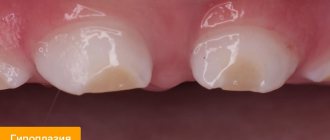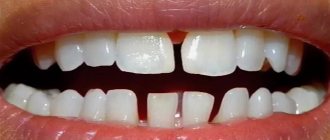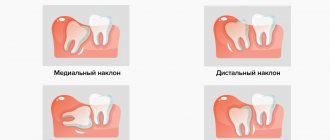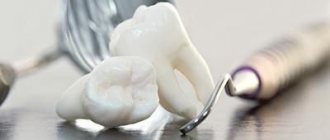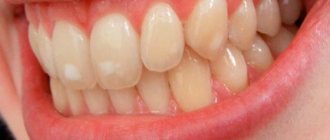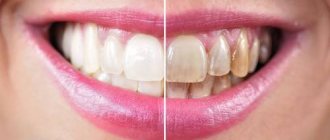Today, many patients when visiting dentistry complain about the loss of the natural shade of tooth enamel. Why does enamel become dull and lose its natural color? There are actually a huge number of reasons, and it is to them that we will pay attention today, but a little further. Now we note that this problem can be dealt with using modern teeth whitening technologies, Zoom whitening, Brite Smile, Opalescence, which are successfully used in medical science.
Changing the color shade of tooth enamel: varieties
There are two types of loss of natural tooth enamel color:
- Internal change. Occurs in the inner part of the tooth structure - dentin. The tooth becomes covered with gray, yellow spots or darkens.
- External change. The process takes place in the outer layer; deterioration is indicated by the appearance of yellow spots, white stripes, and dips on the surface of the tooth.
It is worth noting that external discoloration can be treated with special whitening technologies. Internal change is more difficult to cure. Its treatment may require aesthetic methods, such as veneers.
Methods to combat tooth staining
Today, there are many options for teeth whitening in dental practice. Patients often try to whiten enamel at home, using cheap and very aggressive means - citric acid, activated carbon, hydrogen peroxide solution. The specialists at Dr. Granov’s dental clinic strongly do not recommend that you engage in such “amateur activities.” The maximum you can achieve using these methods is a slight lightening of 0.5-1 tone, and only if you regularly use the recipe. In this case, your enamel will suffer catastrophically - it will become thin, fragile and hypersensitive. The only acceptable method of dealing with teeth staining at home is the use of professional solutions and whitening toothpastes. Consult a specialist regarding the selection of such a product. In our clinic you can access the following services:
- Whitening “Air Flow”;
- Whitening "ClinPro";
- Teeth whitening “Opalescence”;
- Whitening “ZOOM3”;
- Whitening using laser equipment.
We also provide a professional ultrasonic cleaning service, which can make your teeth 1-2 shades lighter, returning them to their natural whiteness. Sometimes this is enough to achieve results. Our specialists offer their patients the service of selecting home whitening products (trays and solutions). In some cases, non-invasive whitening is not enough, and the dentist may offer you artistic restoration methods (veneering, lumineering, etc.). If you want to find out the reason for the staining of your teeth, or want to get rid of the problem of yellowing of the enamel, we invite you to an in-person consultation at our clinic.
The main reasons for changes in the shade of tooth enamel
- Consumption of food and drinks. Internal spoilage can occur from eating a wide variety of foods if proper oral care is not maintained.
- Tobacco use causes damage to the outer layer of tooth enamel.
- Inadequate dental care. If you do not brush your teeth regularly or with low-quality toothpastes, there is a risk of discoloration of the enamel.
- Use of medications. Any medications for high blood pressure can affect your dental health. If a pregnant woman uses tetracycline antibiotics, there is a risk of loss of color of the enamel and the newborn.
- Diseases. There are some infections in pregnant women that can affect the color of the newborn's tooth enamel, and teeth can also lose their natural color in case of dentin disease.
- The presence of dentures in the case of using silver amalgam during care can give the enamel a grayish tint.
- Genetic predisposition.
- Aging. As you age, tooth enamel may become yellowish. Also, soft or hard plaque may form on the surface of the teeth, which also causes discoloration of the teeth.
- Medical procedures. There are procedures, for example, chemotherapy, in which one of the side effects is the effect on the color of tooth enamel.
Most often, a person can cope with the problem, especially if it is caused by an external discoloration. All that is required is regular visits to the dental office and proper hygiene using quality toothpastes.
Immediately after eating food or drinks (red wine, tea, coffee), it is recommended to immediately rinse your teeth with water, but it is better to brush your teeth with toothpaste. After smoking, it is also necessary to brush your teeth, otherwise an unpleasant yellowish tint may appear on the tooth enamel in the near future.
Internal discoloration
Internal discoloration of teeth is formed due to deep changes in the hard tissues of the tooth: dentin and enamel.
The following factors can lead to changes in the shade of tooth enamel.
- Consuming water with high fluoride content. Excess fluoride, settling on the surface of the enamel, makes it matte and softer. Subsequently, dyes accumulate in these areas, changing the color of the enamel.
- The carious process, causing demineralization and destruction of the organic matrix, promotes the penetration of microorganisms deep into the tooth tissue. Brown and black spots form at the site of the lesion.
- Long-term use of certain medications - tetracyclines, hormones.
- Natural aging. With age, the processes of enamel remineralization slow down, it becomes thinner, and in combination with external factors, its darkening develops.
- Violation of the rules of endodontic treatment. With poor quality treatment, pathogenic microbes continue to multiply in the root canals, the waste products of which are sulfide compounds. These compounds, penetrating through the dentinal tubules into the hard tissues of the tooth (dentin, enamel), stain them dark.
- Pulp removal. A change in the color of pulpless teeth is observed when certain filling materials are used in their treatment:
- filling with Foredent or paracin gives the tooth crown a pink color;
- the silvering method causes a gray or dark gray coloration of the enamel;
- the use of iodoform-containing pastes leads to yellowing of the tooth.
- When tooth depulpation occurs, trophic processes are disrupted, which leads to a deficiency of mineral and organic components. As a result, the optical density of dental tissues changes, and consequently, the color of the tooth.
- Trauma that leads to damage to the vascular bundle of the pulp. Significant hemorrhage changes the color of the tooth from reddish to pink or orange. The combination of necrosis of pulp tissue together with iron heme gives a gray, blue, brown color.
Dental abnormalities that may cause discoloration of tooth enamel
Changes in tooth color can occur as a result of changes in their size or shape. The color of the tooth may change depending on the number of teeth and the period of eruption.
Complete edentia is extremely rare, but the absence of several teeth is a common pathology. It is explained by endocrine disorders, which can cause a delay in teething and, as a result, a change in color.
With tuberculosis, neurological diseases, rickets, retention of the molars, as well as the upper canines (permanent), occurs.
In diseases associated with osteogenesis, patients most often have small teeth and a bluish tint to the tooth enamel. It is worth noting that the teeth of people with such diseases wear out quickly and are especially susceptible to disease. Pathologies in the development of dental dentin and tooth enamel cause amber, opal, bluish and brown tints of teeth and insufficient size.
How to choose teeth color
The practice of an orthopedic dentist involves the need to choose the shade of dentures. When making prosthetics or restoring one or more teeth in a row, the color is selected in accordance with the patient’s natural teeth. When making complete removable or fixed orthopedic structures, the patient has the opportunity to choose the desired color of the teeth. In this case, you should focus not only on your own desires, but also on the shade of your skin, hair and eye whites. Typically, teeth that are much lighter than the whites of the eyes look unnatural and stand out too much when you smile. In addition, the material from which the crowns or veneers are made should also be taken into account. Thus, plastic and composite materials used to restore teeth look different than metal-ceramics, even with the same color index.
Please note that the color of teeth will be perceived differently in different lighting conditions. That is why, when choosing the shade of veneers or dentures, it is necessary to follow a whole list of conditions, such as natural light, neutral color of the walls in the room and the clothes of the patient and the doctor, the absence of bright lipstick on the lips, and so on.
How to restore the color of tooth enamel?
In many cases, with the exception of diseases and pathologies, patients have every chance to influence and change the color of tooth enamel for the better, without even going to the dentist. The surest way is to eliminate all foods and drinks that contain food colorings.
In difficult cases, various modern technologies, professional teeth cleanings help restore whiteness, and in the most difficult cases, prosthetics are performed.
There are many ways to restore the natural color of enamel; by contacting our center, each patient can count only on quality, namely the complete restoration of tooth enamel.
Exogenous (external) factors
In the vast majority of cases, enamel changes its color under the influence of exogenous factors that you can neutralize. This occurs at different periods of life and depends on the individual characteristics of the structure of the teeth. The enamel itself has a bluish or pinkish tint, and the visual perception of tooth color usually depends on the underlying dentin, which can be yellow or brown. In fact, it is dentin that determines the natural shades of human teeth, as well as the thickness, density, transparency and degree of mineralization of the enamel. The reasons for enamel staining are conventionally classified as external and internal. With external staining, chromogens (pigments) are introduced into the tooth on their own; with internal staining, they form inside the dentin. The second case is caused by systemic pathological processes in the body. Sometimes internal staining can result from endodontic diseases, when chromogens penetrate into the internal structures of the tooth through its defects. Among the external (exogenous) causes of enamel staining, it is worth highlighting:
- Consumption of certain drinks and foods. These usually include coffee and tea, and black tea has a stronger effect on the shade of teeth, contrary to popular misconceptions. In contrast, coffee does not contain a high concentration of tannins, which affect the whiteness of teeth. This category also includes wines and concentrated berry juices, although they are drunk less often in our country than traditional hot drinks.
- Smoking. The fact that smoking cigarettes, cigars, cigarettes and pipes negatively affects the color of teeth has been clinically proven. Smokers' teeth almost always turn yellow - it's just a matter of time and experience. Over the course of life, the enamel of a smoker may even acquire a brown or black tint.
- The use of topical antiseptics like chlorhexidine for rinsing can also negatively affect the shade of the enamel. Sometimes this occurs while taking medications with metal salts (for example, silver). In this case, the teeth may even become bluish.
- Mechanical injuries. An injured tooth almost always becomes stained over time, since it is very easy for chromogens to penetrate into the internal structures through chips and cracks. This also applies to advanced caries or pulpitis, but not in all cases.
- Poor oral hygiene. The plaque itself has a yellowish tint, and if it thickens, the smile takes on a corresponding appearance. Not to mention the fact that poor hygiene is a common trigger for the development of various pathologies of teeth and soft tissues of the oral cavity.
Surface stains are the easiest to bleach, both at home and professionally. At Dr. Granov’s dental clinic, we are ready to offer you innovative and safest whitening methods , including the most popular “ZOOM3”. We recommend that all our patients regularly seek professional dental cleaning . The procedure takes place on an outpatient basis and is performed using an ultrasonic device that removes dense plaque and tartar. Next, the enamel is polished using an abrasive paste. The final manipulation is polishing the enamel with a special solution, which helps protect teeth from destruction and unwanted pigmentation. If you want to keep your teeth white, you need to have a professional cleaning at least once a year, preferably twice. During the cleaning process, carious lesions are sometimes discovered in the early stages, which can be treated with a non-invasive remineralization method.
What is plaque on teeth?
Unpleasant plaque is nothing more than a film-like accumulation of bacteria that forms on the teeth. Yes, such an accord creates an unpleasant color of the enamel, “gives” the owner bad breath and ultimately has a detrimental effect on the health of the teeth and gums.
The fact is that plaque is often caused by tartar, which negatively affects the enamel and also provokes inflammation of the gums.
Why does plaque form on teeth?
Typically, plaque formation is caused by several factors. The most common causes of black or yellow film on crowns are:
- Irregular, improper oral hygiene.
- Eating exclusively soft foods and avoiding fresh fruits and vegetables, which naturally remove plaque.
- Defects in tooth growth, malocclusion, and, as a result, difficulty in cleaning them.
- Negative effects due to taking certain medications.
- Periodontitis is an inflammation of the tissues surrounding the roots.
And, of course, those at particular risk for the appearance of black, yellow and brown plaque on the teeth are coffee and strong tea drinkers, smokers, as well as those who like to eat highly colored foods.
Bruise is the most common cause of tooth defects and discoloration.
More often, darkening of the tooth is observed after an impact. Young children are active and explore the world through play. Often their excessive activity leads to falls and, consequently, bruises. The greatest number of visits to the doctor with this problem occurs between the ages of 1–3 years. A child’s tooth can become damaged even after it has been replaced, since children reach their peak physical activity at 8–9 years of age. In addition to an accidental fall, other possible causes of tooth injury:
- An accident in which there was a blow to the jaw;
- bad habits, such as biting nails or the tip of a pen;
- playing sports;
- leisure;
- hitting a utensil - glass, spoon, etc.;
- biting into super hard food.
The structure of the primary occlusion is similar to the permanent one. Not everyone realizes that the first teeth also have roots, thanks to which they receive calcium and other necessary microelements from the periodontium. The pulp and network of nerve plexuses are responsible for the sensitivity and healthy condition of the tooth. This fragile system can be damaged by a strong impact.
Mechanical impact with a hard object on a tooth provokes damage to periodontal tissues. If the integrity of the neurovascular bundle is disrupted, hemorrhage may occur in the dentinal tubules and pulp tissue, which manifests itself in the form of staining or darkening of the tooth. Enamel also becomes dull due to a lack of nutrients supplied through damaged fibers and tissues.
